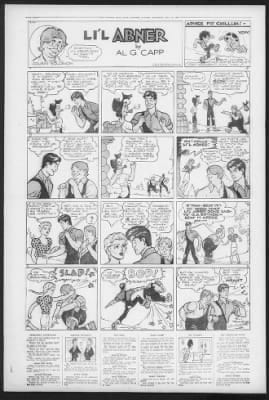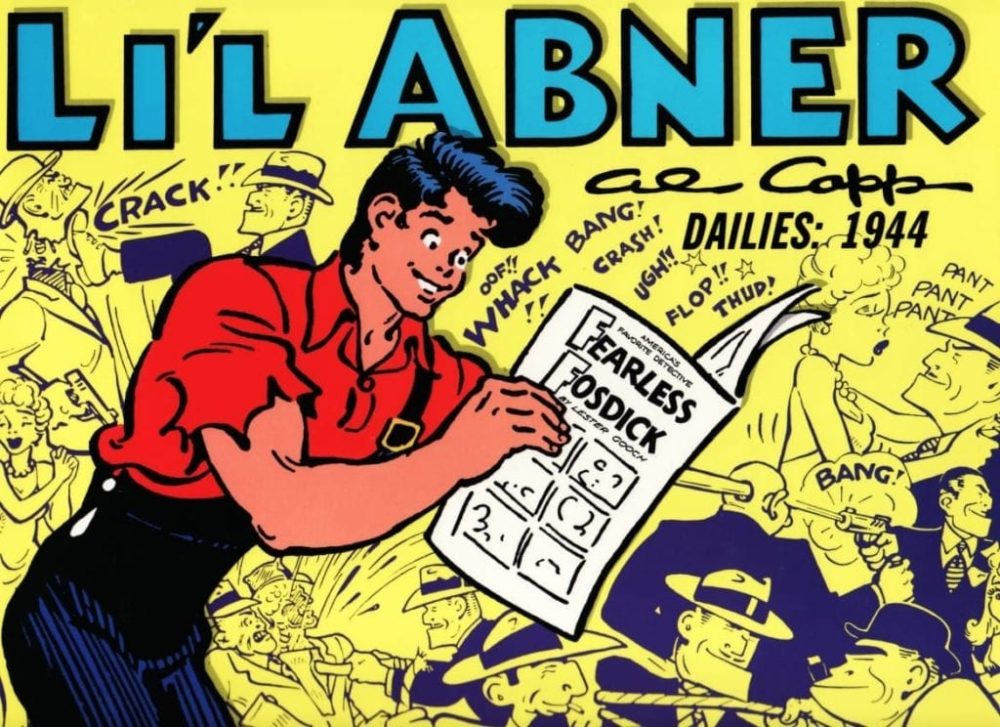The baddies in Li’l Abner may not have super-powers, but they sure can be a nuisance. Much like their contemporary comicbook super-villains, though, some of Li’l Abner’s villains prove to be more of a nuisance than others. From Marryin’ Sam, the lovable grifter, to Baron Slinkovitch, the rat-faced conman out to bilk Aunt Bessie out of her millions, several levels of dastardliness are covered in the first year of Li’l Abner’s publication.

Li’l Abner’s Villains: Marryin’ Sam and Other Lovable Grifters
The least offensive of Dogpatch’s villains is likely Marryin’ Sam. The absent-minded grifter, always after a free meal and a quick buck, performed the first marriage ceremony between Li’l Abner and Daisy Mae. Unfortunately for Daisy Mae, Sam had long since lost his marryin’ license. A relieved Li’l Abner survived another 20 years as a bachelor, but love — and Daisy Mae — eventually had their way when Abner and Daisy Mae finally got hitched in the ’50s.
Other notably lovable grifters include Fishface and Hollowhead, who kidnap Pappy Yokum in an attempt to get rich quick by ransoming Pappy for four whole dollars! Never to be out-grifted, though, Marryin’ Sam worms his way into the story, outmaneuvering the two other scoundrels, and securing the fortune for himself.
In one of my favourite story-lines, the three villains above conspire to rig a beauty contest only to be foiled by Mammy Yokum, who ends up winning the contest herself.
Daisy Mae’s Suitors
Daisy Mae’s myriad spurned suitors make up a slightly more conniving layer of Dogpatch’s seamy underbelly. Whether it’s Abijah Gooch or Hannibal Hoops, the non-Yokum male constituents of Dogpatch just don’t seem to know how to treat a lady.
Li’l Abner’s famous distaste for “girls” notwithstanding, he or Mammy Yokum always makes sure that no one treats Daisy too roughly … or too well. One particular episode that had me, and probably several readers, laughing out loud involved the lovelorn Hannibal Hoops trying to discredit Li’l Abner, his perceived romantic competition for Daisy Mae’s affections.
Dressed as the ghost of Daisy Mae’s learned cousin Judge Scragg, who — being a ghost — is supposed to be omniscient, Hoops tells Daisy Mae an unprinted but, the reader is assured, horrible secret about her true love Li’l Abner.

Lucky for Daisy Mae, Mammy appears and clears the air. Mammy tricks the “ghost” into saying that he remembers kissing Mammy long ago. This exposes the ghost as a fraud. There was no kiss. Mammy, rather adorably, states that the only man she has ever kissed is Pappy. Awwwwww … Mammy socks the ghost, tears off its mask, and exposes Hannibal Hoops for the fraudster he is.
Li’l Abner’s Cousin Solomon also finds out how complicated it can be to interact with Daisy Mae when he gets walloped by both her and Li’l Abner for sounding “like he meant it” when, mimicking his charming cousin, he tells Daisy Mae to get lost.
Li’l Abner’s Villains: The Sadistic Ex


Sadism has no place in Dogpatch, so Nellie Noggins, Pappy Yokum’s ex-fiancée who he left at the altar, occupies the next level of villainy on this list.
Although her torture methods are somewhat pedestrian — she eats pork chops in front of Pappy and then has a dog lick molasses off of his feet (some people’s idea of a fun Friday night) — it’s her motives that make her a villain.
She might call herself Nellie Noggins in this story, but faithful Li’l Abner readers should recognize Ms. Noggins as Granny Groggins, from Capp’s ill-fated Washable Jones comic strip. Washable Jones was a two-line supplemental strip at the bottom of Li’l Abner‘s four-line Sunday strip. Noggins, as gigantic and monstrous as Pappy is diminutive and cute, never got over the pain of being left at the altar for Mammy, the superior po’k chop cooker.
Li’l Abner’s Villains: The Scraggs
Although this story-line eventually resolves peacefully, the feuding Scraggs from Skunk Hollow, especially Lem Scragg, take their blood feud with the Yokums quite seriously. After the Scraggs take over their cousin Daisy Mae’s house, Abner eventually finds himself motivated to toss the invading Scraggs out on their ears. No surprise; Mammy and Li’l Abner solve the dispute with a left, a right, and a threat of further violence. Sure, the good guys used a little intimidation and corporal punishment, but at least no one had to use a shootin’ iron.
Li’l Abner’s Villains: Professional Con-Artists
The most reprehensible constituents on this list are two con-artists without any redeeming merits, Baron Slinkovitch and Cynthia Astorbux. The dastardly Baron Slinkovitch of Skurvia tries to lure Abner’s beloved Aunt Bessie into a sham marriage so that he can steal her fortune — Skurvian law dictates that all property previously belonging to the wife becomes her husband’s after marriage.
Abner manages to out Slinkovitch as the villain he is by, first, forcibly shaving off Slinkovitch’s lustrous beard, and then tricking him into losing his temper and revealing his plan in front of Aunt Bessie … oldest trick in the book.
Cynthia Astorbux occupies the same level of immorality. Seeking her niece’s vast $10-million fortune, she faces off against her sister Agatha, attempting to influence her niece’s decision by getting on her niece’s friend Abner’s good side. Abner, lovable doofus that he is, goes for Cynthia’s act hook, line, and sinker. Luckily, young Mary-Ann Astorbux is no fool. Eventually convincing Abner that Cynthia is not the tenderhearted damsel she represents herself as, Mary-Ann and Abner escape the clutches of her greedy aunts. They escape to Dogpatch where Mammy, once more, sets all aright.
Mammy convinces the judge in charge of the dispute to set Mary-Ann’s money aside in a trust fund that neither of her aunts can touch. When only Agatha, who finally sees the light and realizes that taking care of her darling niece is its own reward, agrees to Mammy’s terms, all becomes well.
One wonders what the hell this judge is getting paid for, but there we are.
Y’all Come Back Now, Ya’ Hear?
That about does it for my articles on the first year of Li’l Abner‘s publication. Following decades of publication saw the introductions of popular characters and properties like Joe Btfsplk, Fearless Fosdick, and, of course, the lovable Shmoos.
Thanks for reading this and my other articles on the origins of Al Capp‘s comic strip that spawned a global commercial empire. The Golden Age of comicbooks has its highs and its lows. Capp’s work on Li’l Abner marks a veritable apex in Golden Age Comics. Along with fellow innovators Charles Schulz, Will Eisner, Chester Gould, Steve Ditko, Carl Barks, Jack Kirby, Stan Lee, Bill Everett, Carl Burgos, Floyd Gottfredson, and others, Capp showed readers how good sequential art could be. He had an undeniable knack for using caricature to translate issues of the day into easy-to-unpack ideas.
That Capp could be accused of oversimplification goes without saying. And, like many of his contemporaries, Capp frequently came down on what many would call the wrong side of history, but his loving pastiche of southern culture provides more than just stereotype and prejudice. Whether Capp’s pastiche is accurate or not is open to interpretation, but none can deny its charm or Capp’s obvious devotion to his subject.


